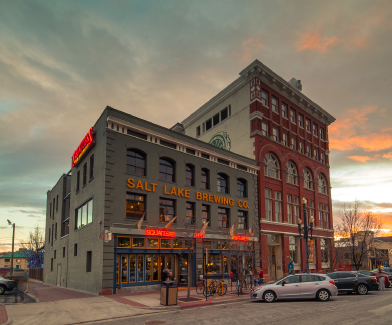 Salt Lake City has been saved by beer. While some readers might scoff at this notion, or think the author is engaged in “drunk writing,” keep an open mind and keep reading. Thanks to beer, since the early 1980s, Utah cities have been revitalized by the local beerloving masses.
Salt Lake City has been saved by beer. While some readers might scoff at this notion, or think the author is engaged in “drunk writing,” keep an open mind and keep reading. Thanks to beer, since the early 1980s, Utah cities have been revitalized by the local beerloving masses.
First came Squatters. In 1989 owners Peter Cole and Jeff Polycronis decided to gamble by opening in the “red light” district of Salt Lake City at 200 West 300 South. They realized they might have a difficult time convincing residents that downtown was safe enough to enjoy fine craft beer. Also, they were opening a brewpub in a state where most residents might imagine the term “Utah micro brew” as a very tiny glass of beer.
Luckily for Squatters owners, one of their Park City real estate pals, Greg Schirf, had initiated a change in Utah liquor laws to allow micro brewpubs, a place where beer can be both brewed and consumed in the same location. That law also allowed serving large steins of beer. It might have been thanks the word “micro” in the title of the measure that made Utah lawmakers assume the change of the law would have a very minimal impact. What they didn’t realize is that the micro brewpubs would in fact play a huge role in revitalizing Utah’s decaying city centers.
Squatters opened in downtown Salt Lake City in 1989, and despite its seedy location it was an immediate hit. Squatters’ success attracted other investors that helped transform the area, including a huge donation by the estate of Izzy Wagner, which opened the Rose Wagner Performing Arts Center across the street. For years it has hosted performances by both local theater and dance, as well the Sundance Film Festival.
But to be fair, the urban renewal of downtown had other “nonbeer” key players. John Williams and Tom Sieg opened the New Yorker restaurant in 1978 and brought on chef Tom Guinney to open the Market Street Grill in 1980 and launch the parent company, Gastronomy. The opening of these two restaurants required massive amounts of remodeling and bringing to code the New York Building that had been previously condemned by the city. The young ambitious Sieg and Williams found investors, revitalized the classic architecture and restored gems to the enjoyment of everyone who appreciated Utah’s architectural heritage. While good food could be enjoyed in downtown, there was a giant gaping hole where there should have been good music, too.
Otto Melletti determined to fill the vacuum in 1985 when he opened the Zephyr Club. Despite its small size, Zephyr hosted huge names like The Police, English Beat, as well as upandcoming rock, punk and rap stars like Red Hot Chili Peppers. These bands would travel in their tour buses from the East to West coasts. The Zephyr was an overnight stop that felt like a lowkey lounge, intimate and inviting compared the huge venues on either coast. The connection between artist and audience at Zephyr was unprecedented and nearly anybody in SLC during the late 80s or early 90s has memories of the Zephyr.
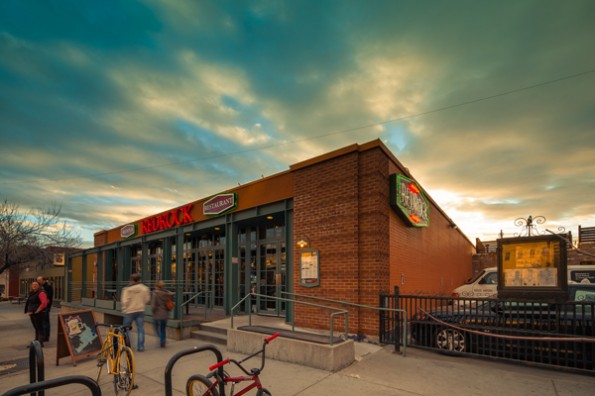
These faithful few risk taker/entrepreneurs/ handymen demonstrated that despite excessive blight and urban decay, downtown real estate was a bargain in the 1980s, and downtown (outside of the LDS Church-owned malls) offered unique and culturally rich gathering places. The common trait among these visionary men was their commitment to serving quality, whether in music, beer or food. This was the key to attracting the mall going suburbanites. But without local craft beer, this critical mass of draw to revitalize downtown would have never been possible.
Five years after Squatters opened, the demand for local high quality beer was so great, there was room for another brewpub. Red Rock opened just a block and a half away in 1994. Rather than seeing each other as archrivals, the two head brewers, Kevin Templin and Jennifer Talley, became friends, sharing recipes, techniques and improving each other’s games. They congratulated each other for their award winning beers. Now that 300 South was seeing revitalization thanks to Squatters and 200 West was revitalized thanks to Red Rock, Squatters thought it would further revitalize an even seedier part of downtown by taking its biggest gamble yet.
It attempted to expand to a second location, much farther west—400 West and 350 South, right across the street from Pioneer Park. Unfortunately drug dealers and transients did not vacate despite the big investment and presence of yuppie craft beer drinkers. Squatters new brewpub, Fuggles “at the big brewery,” struggled for a few years, and Squatters’ efforts to satisfy the growing demand for its beers in bottles became the greatest challenge to its growth.
The problem would be eventually solved by partnering Squatters with Wasatch Beers to build a unified, dedicated brewing facility. The Utah Brewers Cooperative was born, and it launched the brands of Squatters and Wasatch into household names for Utah beer consumers.
A Repeatable Model
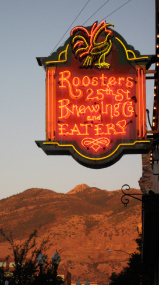
The same model that helped revitalize downtown Salt Lake City was also applied to the cities of Ogden and Park City. Roosters opened on 25th Street in Ogden by husband/wife partners, Pete and Kym Buttschardt. “It was a similar story there for sure,” says Pete Buttschardt. “It was pretty run down, a lot of empty spots. It really wasn’t that easy to get a certain generation of people to come down to 25th Street.” Ogden was suffering, and still suffers in parts, from an excessive drug trade.
Since the revitalization of Ogden’s 25th Street, the areas blighted by drug use are fewer and farther between. Roosters partners with fellow manufacturers in the area such as Beehive Cheese. Their entrees feature locally sourced ingredients. And now Ogden’s 25th Street has many local restaurants and shops that are a strong draw for staycationers and ski tourists. Snow Basin ski resort is just 20 minutes from the heart of Ogden.
In Park City Greg Schirf started Utah’s first brewery in 1986. But when he was able to effectively change the micro brewpub law, it became a clear path of growth to open his own brewpub. Park City at the time was mostly boarded up old buildings left over from the previous mining era. Schirf partnered with his contractor/brother to build his own brewpub on Park City’s historic Main Street. More investment came to Park City when Robert Redford chose Park City as the home for his new Sundance Film Festival. Park City’s Main Street is very much alive today. The old hippy element to the town has been replaced by upscale dining and highend art galleries. Park City is well-known as one of the great ski towns of the West.
A Different Beer Consuming Mindset
Del Vance and Will Hamil were in a fraternity together at the University of Utah. “Back when you could buy beer by the keg in Utah,” says Vance, “we bought some Wasatch Beer for a party, it was a huge hit. Then I realized there is something to this [micro] beer thing.”
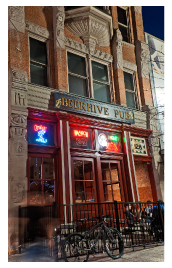
After college Vance and Hamill would all go on to start their own beer businesses. They bumped into each other when they learned they were licensing the same name, Great Basin Brewing Company. They learned the name was taken so they settled on Uinta Brewing. Later Hamil bought out Vance’s share. Uinta went on to become Utah’s largest brewery.
A few years later Vance co-founded the Bayou with Mark Alston. The location they chose was in an old building on State Street beside a homeless youth center. Again beer entrepreneurs were taking a huge risk on a sketchy area. Their concept was Cajun food with an assortment of hundreds of beers from all over the world, along with a huge selection of mostly Utah craft beers on tap. The Bayou was a hit. The co-founder, Mark Alston, had previously started the Beer Nut on State Street, Salt Lake City’s premier home brew supply store.
Ever the entrepreneur, Vance sold out his portion of Bayou and after writing a book, “Brewing in the Beehive,” he then started the Beerhive Pub on Main Street. Restored in the manner of historic Salt Lake’s finest bars before prohibition, Beerhive features handcrafted maple woodwork behind its bar, high ceilings and a huge assortment of beers, fine whiskeys and cocktails.
A Model for Decentralized Wealth Creation
Individuals’ risky investments into derelict old buildings has had the positive influence of decentralizing the economic power of not only Salt Lake City, but cities all over the country. Big developers partnering with corporate chains love to centralize economic power inside their malls owned by few lucky partners and investors.
The authentic revitalization of Salt Lake City has removed this power from outside of the walls of the LDS Church owned malls, into classic historic buildings. The wealth is in the hands of the many rather than the few.
The Next Generation
More recently there has been a second and third wave of entrepreneurs and investment into downtown Salt Lake City. A sad loss to downtown’s bar scene was the beautifully restored Shubrick building, home of Port O’ Call. When this building was razed for a federal courthouse expansion, Deno Dakis and Sean Frehner opened Gracie’s. Former manager of the Port O’Call, Bridget Gordon, opened the Green Pig. Each bar is now into its fifth year of operation and each offers craft brews on tap and elevated outdoor patios bringing new much needed life to downtown.
Three years ago TV actor Ty Burrell (Modern Family), his brother Duncan Burrell David Barnard and Richard Noel decided to open an upscale cocktail bar, buying out one of Salt Lake City’s famous dive bars. They kept the name, Bar X. They removed all the cheap macro brews and replaced the taps with fine craft brews, but their signature drinks have been their cocktails.
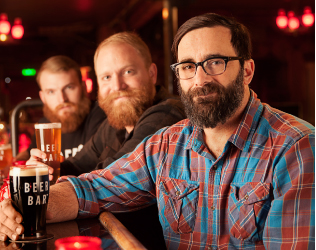
Four months ago, Sara Lund opened Bodega at 331 South Main, an unassuming convenience store with a few beer handles. Bodega has a secret underground speakeasy called the Rest, complete with giant taxidermy animals and a library. Lund grew up in Salt Lake but previously resided in New York. Her family has slowly returned to Salt Lake and inspired by Bar X, The Rest is a cocktail bar that also serves a variety of finecrafted food.
All of the new beer entrepreneurs greatly appreciate the diversity and culture found in local Salt Lake City. They have a strong emphasis on sourcing their ingredients locally and working with local craftspeople to create their spaces. Lund’s Bodega will be featured in The New York Times, likely by the time this magazine is distributed.
Beer has indeed revitalized Utah, one building, street and neighborhood at a time. Readers might believe I am overzealous in my appreciation for fine craft beer. But examine the history of the world. No great civilization has ever existed absent availability to great beer. And to further the revitalization and local power of Utah, Utah Stories recommends that every city in Utah has its own brewery. Every fan of Utah should understand that every city in Utah that has a temple, should also have a microbrewery. §

